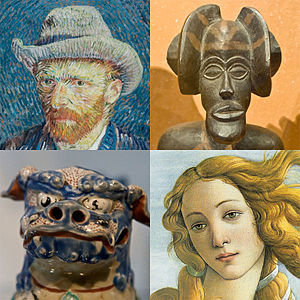about art

Art
Art is the process or product of deliberately arranging elements in a way that appeals to the senses or emotions. It encompasses a diverse range of human activities, creations, and modes of expression, including music, literature, film, sculpture, and paintings. The meaning of art is explored in a branch of philosophy known as aesthetics.
The definition and evaluation of art has become especially problematic since the early 20th century. Richard Wollheim distinguishes three approaches: the Realist, whereby aesthetic quality is an absolute value independent of any human view; the Objectivist, whereby it is also an absolute value, but is dependent on general human experience; and the Relativist position, whereby it is not an absolute value, but depends on, and varies with, the human experience of different humans. An object may be characterized by the intentions, or lack thereof, of its creator, regardless of its apparent purpose. A cup, which ostensibly can be used as a container, may be considered art if intended solely as an ornament, while a painting may be deemed craft if mass-produced.
Traditionally, the term art was used to refer to any skill or mastery. This conception changed during the Romantic period, when art came to be seen as "a special faculty of the human mind to be classified with religion and science". Generally, art is made with the intention of stimulating thoughts and emotions.
The nature of art has been described by Richard Wollheim as "one of the most elusive of the traditional problems of human culture". It has been defined as a vehicle for the expression or communication of emotions and ideas, a means for exploring and appreciating formal elements for their own sake, and as mimesis or representation. Leo Tolstoy identified art as a use of indirect means to communicate from one person to another. Benedetto Croce and R.G. Collingwood advanced the idealist view that art expresses emotions, and that the work of art therefore essentially exists in the mind of the creator. The theory of art as form has its roots in the philosophy of Immanuel Kant, and was developed in the early twentieth century by Roger Fry and Clive Bell. Art as mimesis or representation has deep roots in the philosophy of Aristotle. More recently, thinkers influenced by Martin Heidegger have interpreted art as the means by which a community develops for itself a medium for self-expression and interpretation.







0 Response to "about art"
Posting Komentar